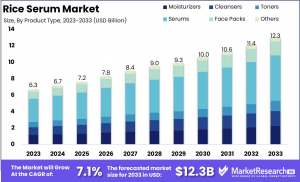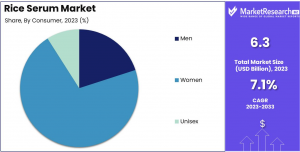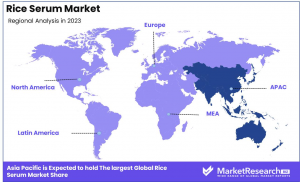Global Rice Serum Market to Reach USD 12.3 Bn by 2033, Growing at 7.1% CAGR
Rice Serum Market was valued at USD 6.3 Bn in 2023. It is expected to reach USD 12.3 Bn by 2033, with a CAGR of 7.1%
Asia-Pacific leads the rice serum market, driven by cultural affinity for rice-based skincare, strong beauty industry growth, and innovations in anti-aging products.”
NEW YORK, NY, UNITED STATES, January 29, 2025 /EINPresswire.com/ -- Market Overview— Tajammul Pangarkar
The Global Rice Serum Market1 was valued at USD 6.3 Bn in 2023. It is expected to reach USD 12.3 Bn by 2033, with a CAGR of 7.1% during the forecast period from 2024 to 2033.
The Rice Serum Market pertains to the growing demand for rice-based bioactive ingredients, particularly in the beauty and skincare industries. Rice serum is derived from rice bran, a rich source of vitamins, antioxidants, and fatty acids. The product is used in cosmetics and skincare formulations to improve skin texture, hydration, and overall appearance. Its natural composition and non-irritating properties have led to increased consumer preference, driving the market's expansion.
The Rice Serum Market is poised for robust growth as consumers continue to shift towards natural and sustainable skincare solutions. With increasing awareness about the benefits of rice-derived ingredients, brands are investing in product innovations to capitalize on the rising demand. Key players are emphasizing the use of rice peptides, ceramides, and other bioactive compounds known for their anti-aging, brightening, and moisturizing effects. This trend is further amplified by a growing focus on clean beauty, which promotes the use of non-toxic, cruelty-free ingredients in cosmetics.
Curious About Market Trends? Request Your Complimentary Sample Report Today: https://marketresearch.biz/report/rice-serum-market/request-sample/
The growth of this market is supported by the expansion of e-commerce platforms, where rice serum products are increasingly available, alongside traditional retail channels. With demand for organic and plant-based skincare products accelerating, rice serum is becoming a preferred ingredient due to its versatility and effectiveness in catering to a wide range of skin types and concerns.
The Rice Serum Market’s growth trajectory has been positively influenced by government initiatives focused on sustainable farming practices and promoting natural cosmetic ingredients. Many governments are increasing investments in agricultural research and development, supporting the use of rice-based products in industries like skincare. This investment not only enhances production but also fosters innovation in utilizing rice by-products for broader market applications. Regulatory frameworks around organic certification and product labeling are becoming stricter, which further elevates the demand for high-quality rice serum products. As these regulations continue to evolve, they drive standardization in manufacturing processes and ensure that end products meet consumer safety expectations.
The Rice Serum Market presents significant opportunities for both new and established companies to drive business growth. For new players, the growing demand for clean, sustainable beauty products offers an entry point to differentiate their offerings in a competitive landscape. For existing players, there is potential for innovation by expanding their portfolios with rice-based skincare products, tapping into both premium and mass-market segments. Additionally, partnerships with agricultural and biotech firms could allow companies to scale production while enhancing the quality and efficacy of their rice serums. With ongoing market expansion and evolving consumer preferences, both new and existing players are well-positioned to capitalize on the burgeoning market.
Key Takeaway
--The Global Rice Serum Market was valued at USD 6.3 Bn in 2023 and is projected to reach USD 12.3 Bn by 2033, growing at a CAGR of 7.1% from 2024 to 2033.
--Serums dominated with a 45% market share, driven by their targeted benefits and potent formulations.
--Sensitive Skin held the highest share at 43%, reflecting the demand for gentle and soothing skincare solutions.
--Women accounted for 71% of the market, showcasing their strong preference for skincare products.
--Online Retail led with a 47% market share, emphasizing the increasing shift towards e-commerce for skincare purchases.
--Asia Pacific led with a 60% market share, fueled by the region's strong cultural preference for rice-based skincare and a well-established beauty industry.
Use Cases
Anti-Aging Skincare Products
Rice serum, rich in antioxidants and vitamins, is commonly used in anti-aging skincare products. It helps to reduce the appearance of fine lines and wrinkles, promote skin elasticity, and improve the overall texture of the skin. As consumers increasingly seek natural and effective anti-aging solutions, rice serum is gaining popularity due to its rejuvenating properties.
Brightening and Even Skin Tone
Rice serum is known for its ability to brighten and even out skin tone. It contains components like niacinamide and other compounds that help reduce hyperpigmentation and dark spots. Many consumers use rice serum in their daily skincare routines to achieve a glowing complexion and a more uniform skin tone, making it a popular ingredient in skin brightening products.
Hydration and Moisturization
Rice serum is a common ingredient in moisturizers due to its ability to hydrate and lock in moisture. The serum’s lightweight texture and nourishing properties make it suitable for various skin types, including dry and sensitive skin. With increasing consumer awareness of the importance of hydration, rice serum is being used in both day and night creams to ensure lasting moisture throughout the day.
Acne Treatment and Prevention
Rice serum is being included in acne treatment products because of its anti-inflammatory properties and ability to balance sebum production. The serum helps calm irritated skin and reduces the risk of breakouts. As more consumers look for natural skincare alternatives to treat acne, rice serum is gaining traction as an effective, gentle solution.
Sustainable and Eco-friendly Beauty Products
As sustainability becomes a growing priority in the beauty industry, rice serum is seen as a natural, eco-friendly ingredient. Rice-based products are often marketed as clean and green, appealing to consumers who prefer products with a lower environmental impact. The market for rice serum is expanding as beauty brands focus on sustainability while offering high-performance skincare solutions.
Driving Factors
Rising Consumer Demand for Natural Skincare Products: Consumers are increasingly seeking natural and organic skincare products free from harsh chemicals. Rice serum, which is rich in antioxidants, vitamins, and minerals, is gaining popularity for its natural ability to brighten skin, reduce wrinkles, and improve overall skin texture, driving market growth.
Growing Awareness of Skin Hydration and Anti-aging Benefits: Rice serum is known for its moisturizing and anti-aging properties, helping to promote youthful, glowing skin. As more consumers become aware of the importance of hydration and the role of natural ingredients in anti-aging, rice serum has gained traction in the beauty and skincare market.
Rising Demand for Multi-functional Beauty Products: Modern consumers are looking for products that offer multiple benefits in one formula. Rice serum is gaining popularity due to its ability to hydrate, brighten, and even out skin tone. This versatility makes it a highly attractive option for those seeking a simple, effective skincare routine.
Cultural Influence and Popularity of Asian Beauty (K-beauty): Rice has been used in traditional Asian skincare for centuries, particularly in countries like Japan, South Korea, and China. The global influence of K-beauty (Korean beauty) and J-beauty (Japanese beauty) has brought rice-based skincare products to the international market, increasing demand for rice serums.
Increasing Focus on Clean Beauty and Sustainability: With the growing popularity of clean beauty, which emphasizes safe, non-toxic ingredients, rice serum aligns with these trends due to its natural sourcing and minimal processing. Additionally, rice is a renewable resource, and many rice serum brands are also focusing on sustainable, eco-friendly packaging, which attracts environmentally conscious consumers.
Report Segmentation
By Product Type
• Moisturizers
• Cleansers
• Toners
• Serums
• Face Packs
• Other
By Skin Type
• Normal Skin
• Dry Skin
• Oily Skin
• Acne Prone Skin
• Sensitive Skin
• Combination Skin
By Consumer Based
• Men
• Women
• Unisex
By Distribution Channel
• Supermarkets/Hypermarkets
• Convenience Stores
• Specialty Stores
• Online Retail
Ready to Act on Market Opportunities? Buy Your Report Now and Get 30% off: https://marketresearch.biz/purchase-report/?report_id=47913
Regional Analysis
Asia-Pacific leads the global rice serum market, holding a substantial 60% market share, driven by strong cultural affinity for rice-based skincare products and a thriving beauty industry.
The region benefits from its rich history of rice cultivation and the growing preference for natural and organic skincare solutions. Countries like Japan, South Korea, and China are major contributors, fueled by high consumer awareness, advanced skincare routines, and significant investments in beauty and personal care industries.
Additionally, the increasing demand for anti-aging, brightening, and hydrating skincare solutions has led to continuous product innovations and strong market expansion. With rising disposable incomes and a booming e-commerce sector, Asia-Pacific is expected to sustain its leadership in the global rice serum market.
Growth Opportunities
Growing Demand for Natural Skincare Products: The increasing preference for natural, organic skincare products is driving the demand for rice-based serums. Rice is known for its anti-inflammatory and antioxidant properties, making it a popular ingredient in skincare, which offers a key growth opportunity.
Rising Awareness of Skin Whitening and Brightening: Rice serum is often marketed for its ability to brighten and even skin tone, addressing the growing consumer interest in skin whitening and brightening products. Brands can capitalize on this by promoting the serum’s effectiveness in achieving a glowing and youthful complexion.
Focus on Anti-Aging Products: Rice serum is also recognized for its anti-aging benefits, such as promoting collagen production and reducing wrinkles. As consumers age, the demand for skincare products that address signs of aging is growing, making rice serums a popular option for targeting this market.
Increase in E-commerce and Direct-to-Consumer Sales: With the rise of online shopping and direct-to-consumer models, businesses can leverage digital platforms to reach a broader customer base. Offering rice serum through e-commerce platforms and social media channels can help companies tap into a growing global market.
Expanding Popularity in Asian Beauty Trends: As the global interest in K-beauty (Korean beauty) and J-beauty (Japanese beauty) trends continues to grow, rice serum is becoming increasingly popular outside of Asia. Businesses can take advantage of this trend by marketing rice serum as a premium, exotic skincare product with roots in these beauty traditions.
Key Players
• L'Oréal
• Amorepacific Corporation
• Johnson & Johnson
• Kao Corporation
• Procter & Gamble
• Avon Products
• Beiersdorf
• Henkel AG & Co. KGaA
• Shiseido
• Revlon
• Colgate-Palmolive
• Estée Lauder
• Unilever
• Coty Inc.
Not Sure? Request a Sample Report and See How Our Insights Can Drive Your Business: https://marketresearch.biz/report/rice-serum-market/request-sample/
Conclusion
In conclusion, the markets analyzed are all experiencing growth driven by evolving consumer preferences, technological advancements, and increasing demand for customized, high-quality products. Key trends, such as the adoption of sustainable practices, integration of smart technologies, and rising disposable incomes, are shaping the competitive landscape. While challenges such as market saturation, price sensitivity, and regional differences persist, opportunities abound for companies to capitalize on niche segments, leverage digital platforms, and innovate to meet the specific needs of their target audiences. As these industries continue to expand, businesses that adapt to changing trends, prioritize customer-centric strategies, and invest in innovation will be well-positioned for long-term success.
Related Report
Luxury Travel Market: https://marketresearch.biz/report/luxury-travel-market/
Cold Brew Coffee Market: https://marketresearch.biz/report/cold-brew-coffee-market/
Water Purifiers Market: https://marketresearch.biz/report/water-purifiers-market/
Shapewear Market: https://marketresearch.biz/report/shapewear-market/
Adult Diapers Market: https://marketresearch.biz/report/adult-diapers-market/
Lawrence John
Prudour
+91 91308 55334
Lawrence@prudour.com
1 https://marketresearch.biz/report/rice-serum-market/



